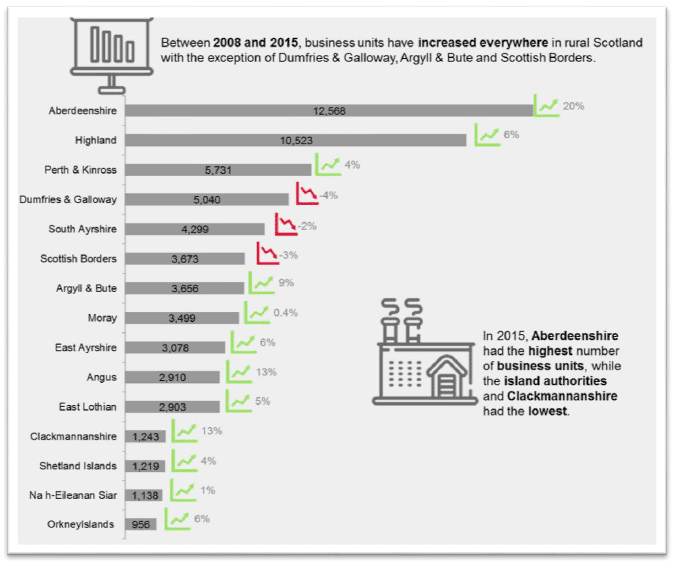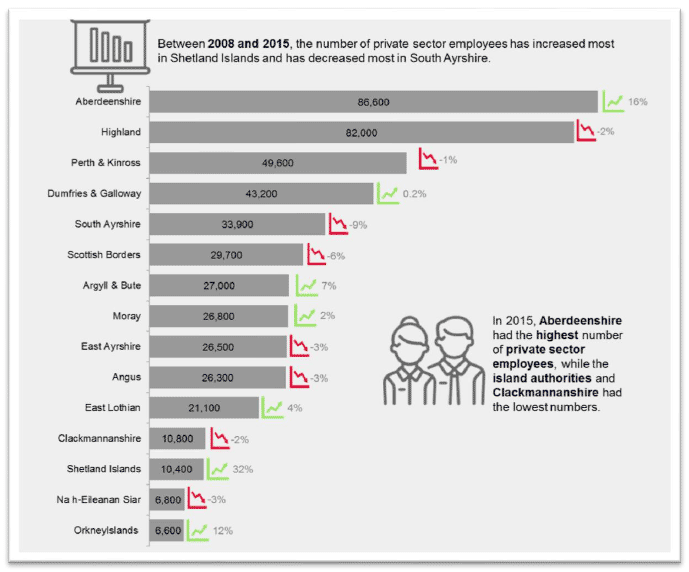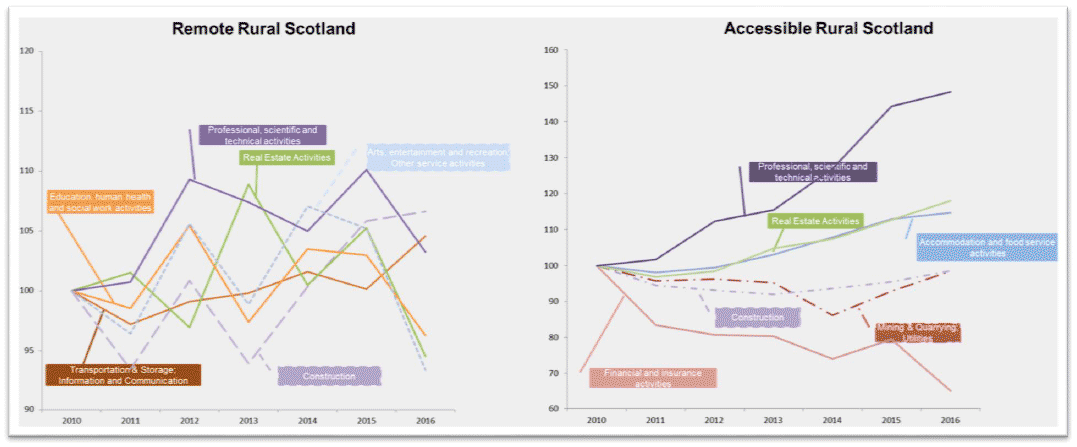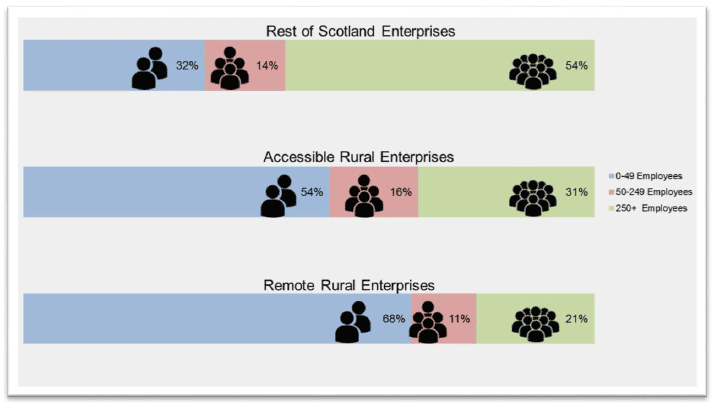Understanding the Scottish rural economy: research paper
This report outlines the Scottish Government's understanding of the Scottish rural economy and presents economic and social data.
The Structure of the Private Sector in Rural Scotland
All data presented so far describes both the public and private sector in rural Scotland. This section aims to examine the structure of the private sector by looking at the number of enterprise units and the size of businesses, private sector employees and growth over time. Looking at the total number of Business Units across the rural local authorities (see chart 12 below), Aberdeenshire (12,415 units) and Highland (10,350 units) stand a long way ahead of the others, followed by Perth and Kinross (5,651 units) and Dumfries and Galloway (5,046 units). Aberdeenshire's economy has had the fastest absolute expansion of business units over the period, growing by nearly 2000 units, (from 10,444 units in 2009 to 12,415 in 2014), where other areas have grown more modestly, and a few, notably Dumfries & Galloway, Scottish Borders and Argyll and Bute, have all had falling numbers of businesses.
Unsurprisingly, those areas with the larger GVA are the same as those with the highest number of Business Units. It may be worth noting that South Ayrshire which has a falling number of businesses also has the highest unemployment rate in rural Scotland. In contrast, Aberdeenshire has one of the lowest unemployment rates, and also shows very significant absolute and relative growth.
Chart 11: Total Business Units in Rural local authorities in Scotland

Source: Inter-Departmental Business Register, as at March 2016 (Using RESAS Classification 2018)
The largest number of private sector employees are in Aberdeenshire 88,000; Highland, 82,000; Perth and Kinross, 50,000; and Dumfries and Galloway 42,000. Aberdeenshire has experienced strong growth in employee numbers (an increase of 13,000), Perth and Kinross mild growth (fewer than 1,000), and Highland (less 2,000) and Dumfries and Galloway (less 1,000) have had falling employee numbers. For all of these areas however there is inter-year variance so the trends should not be seen as uni-directional over the period. The chart below shows private sector employee numbers for each of these areas.
Chart 12: Private Sector Employees in Rural local authorities in Scotland

Source: Inter-Departmental Business Register, as at March 2016 (Using RESAS Classification 2018)
When we compare private sector employee numbers and business units, we can see a pattern evolving. With small employee numbers (fewer than 10,000) and around a 1,000 businesses are the Island authorities and Clackmannanshire. The next group includes a large share of local authorities and has around 30,000 private sector employees and between 3,000 and 4,000 businesses in their district. Thirdly is the pair of Perth and Kinross and Dumfries and Galloway; with around 5,000 businesses and 40- 50,000 employees. Finally are the two giants of Highland and Aberdeenshire with over 10,000 businesses and around 80-90,000 employees. They are significantly larger in GVA than any of the other rural authorities, and together the pair have output of £12.5 billion which means they represent around 36% of the total GVA of rural Scotland.
Private Sector Employment
The Businesses in Scotland Statistics provide an up-to-date picture of some parts of the private sector in Scotland. These show employee numbers, numbers of enterprises, and turnover by sector. Using these statistics we can see threefold urban-rural breakdowns, though they do exclude financial sector businesses, and by definition also the public sector, which provides around 21% of Scotland's GVA. [7] Analysing Business in Scotland data one key area that stands out is in employment growth in rural Scotland. Over the six years from 2010 it is possible to look at the relative performance in job growth by sector.
The chart below shows different patterns of job growth in the private sector. Because data here is available at the data zone level, we can apply the SG Urban/ Rural classification and distinguish between Accessible Rural and Remote Rural Scotland. Accessible Rural Scotland has had two strong trends in employment. Firstly, a strong rise in professional, scientific and technical jobs. These are generally high skill and high productivity sectors, which is positive news. There has been a strong decline in financial services sector jobs over the same period which is unsurprising given the financial crisis. Only two other sectors have had declining jobs numbers: utilities, mining and quarrying; and construction, both clearly affected by world markets, and related issues. Two further sectors have seen no growth between 2010 and 2016. This is because there has either been no growth at all or growth and decline bring them to be the same size at the end as at the beginning in jobs terms, administration and support services; and agriculture, fisheries and forestry.
Chart 13: Strongest and weakest relative job growth in the Private Sector between 2010 and 2016 (2010=100)

Source: Inter-Departmental Business Register via Business in Scotland Statistics, as at March 2016 ( RESAS Analysis 2018)
The picture for Remote Rural Scotland is somewhat different, though the number of jobs overall are of course smaller. Chart 13 shows that there is not the same spread in performance as there was in Accessible Rural Scotland. However, overall whilst only 3 sectors had shrunk in jobs terms in Accessible Rural Scotland, several sectors had fewer jobs in 2016 than 2010 in Remote Rural Scotland. The sectors with reducing employment numbers in Remote Rural Scotland were: 'Agriculture, Fisheries and Forestry'; 'Accommodation and Food Services'; 'Financial Services'; 'Real Estate'; (private sector) 'Education, Human Health and Social work'; and 'Arts and entertainment'. As in Accessible Rural Scotland the decline in employment in financial services had been the most severe. There was employment growth in 'Professional, Scientific and technical activities'; 'Construction'; and 'Transportation'; and there may have been growth in 'Mining and utilities', but because there is little data available for this sector, it is hard to be sure.
Structure of the Private Sector in Rural Scotland
Enterprises in the private sector within Scotland have a similar structure across the urban/rural categories when broken down by employee size band. As shown in the table below the overwhelming number of enterprises in urban and rural Scotland have fewer than 50 employees, though larger businesses are slightly more common in Accessible Rural areas and in the rest of Scotland.
Table 6: Percentages of Enterprise numbers by Urban/Rural Category and by employee size band, 2016
| Employee Numbers | Remote Rural Enterprises % | Accessible Rural Enterprises % | Rest of Scotland Enterprises |
|---|---|---|---|
| 0-49 | 97% | 96% | 95% |
| 50-249 | 1% | 2% | 3% |
| 250+ | 1% | 2% | 2% |
| Total | 100% | 100% | 100% |
Source: Inter-Departmental Business Register via Business in Scotland Statistics, as at March 2016
However, whilst the structure of the enterprises is largely similar, the structure of employment within those private sector enterprises is distinctly different. The overwhelming majority (68%) of employees in the private sector in Remote Rural areas work in small businesses with fewer than 50 employees. It is similar but less pronounced in Accessible Rural areas where 54% of employees work in small businesses. By contrast in the rest of Scotland only 34% of private sector employment is in small businesses whereas 54% of employment is in businesses with 250 or more employees. This is shown in the chart below
Chart 14: Percentages of Private Sector Employees within each Urban/Rural Category by employee size band, 2016

Source: Inter-Departmental Business Register via Business in Scotland Statistics, as at March 2016 ( RESAS Analysis 2017)
Looking at the group of small businesses more thoroughly, the Scottish Government's Topic Report (2016) found that 87% of Accessible Rural and 81% of Remote Rural SMEs were microbusinesses with 1-9 employees. 11% of SMEs in Accessible Rural areas were small businesses (10-49 employees) compared to 18% in Remote Rural Scotland.
Contact
There is a problem
Thanks for your feedback